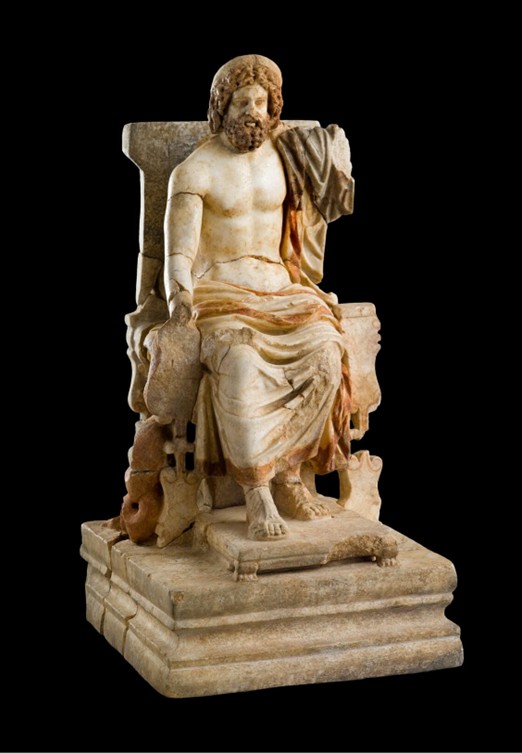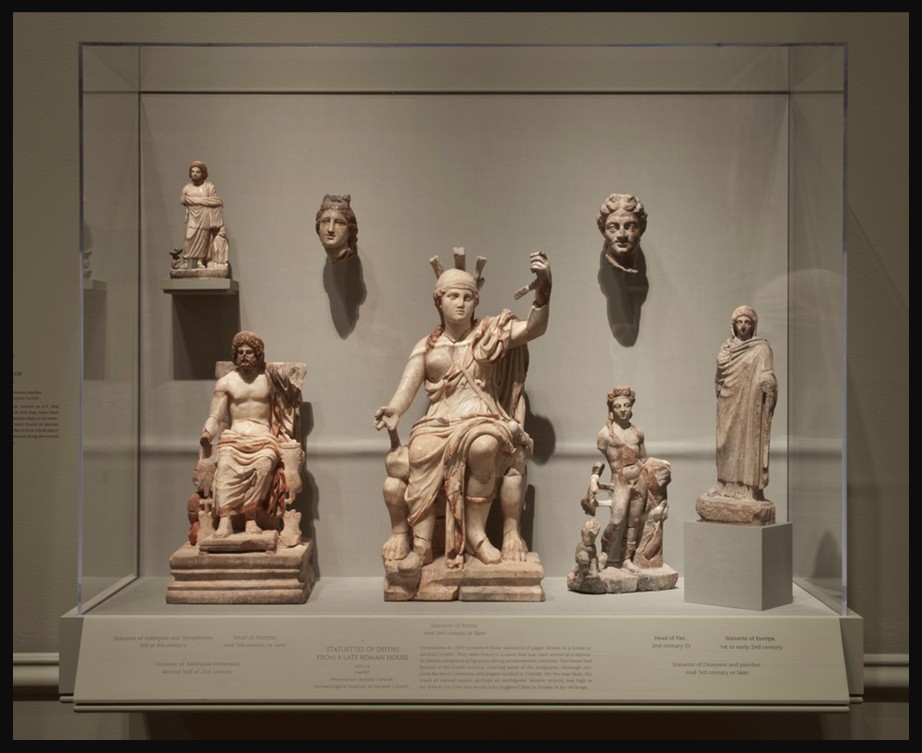
…Asclepius, that gentle craftsman who drove pain from the limbs that he healed, that hero who cured all types of diseases… as Pindar writes in Pythian 3, was the ancient Greek god of medicine and healing, both revered and deified for his mastery over human suffering. This divine healer is brought vividly to life in the Statuette of Asklepios Enthroned, crafted in an Athenian workshop between 150–200 AD and now housed in the Archaeological Museum of Ancient Corinth. Carved from marble and standing 42.3 cm tall, the figure captures Asclepius in a moment of quiet authority, seated with the familiar serpent-entwined staff at his side—a timeless symbol of restoration and medical care. Though created centuries after the height of his cult, the statuette reflects the enduring presence of Asclepius in both public worship and private devotion, embodying the belief in divine healing that spanned from the classical world into the Roman era. https://www.perseus.tufts.edu/hopper/text?doc=Perseus%3Atext%3A1999.01.0162%3Abook%3DP.%3Apoem%3D3
The Ancient Greek myths of Asclepius tell the story of a mortal born to the god Apollo and the human woman Coronis, who was raised and taught the healing arts by the wise centaur Chiron. Gifted beyond any healer before him, Asclepius became so skilled that he was said to cure incurable diseases and even bring the dead back to life. This miraculous power, however, drew the ire of Zeus, who feared that such abilities would upset the natural balance between life and death. In response, Zeus struck Asclepius down with a thunderbolt, ending his mortal life but paving the way for his deification. Worshipped across the Greek world, particularly in healing sanctuaries known as Asclepieia, Asclepius became a symbol of divine compassion and medical wisdom, bridging the realms of myth, religion, and early medical practice.
The healing sanctuaries of Asclepios become some of the most important religious and medical centers of the classical world. The most famous of these was at Epidaurus in the northeastern Peloponnese, a sprawling complex that included temples, dormitories for dream incubation, and even a theater. Other major centers of his cult were located on the island of Kos, where the physician Hippocrates is said to have trained, and at Pergamon in Asia Minor. In Athens, he was worshipped at the Asclepieion located at the foot of the Acropolis, near the Theater of Dionysus. These sanctuaries attracted the sick and afflicted from across the Greek world, who came seeking cures through ritual purification, offerings, and dreams in which Asclepius or his sacred serpent revealed treatments. His worship was not only a spiritual experience but also a foundational element in the evolution of ancient medicine.

The Statuette of Asklepios Enthroned, now housed in the Archaeological Museum of Ancient Corinth, was discovered during 1999 excavation period (by the American School of Classical Studies) of a domestic shrine within a luxurious Roman villa in the Panayia Field area of Corinth. The villa was destroyed by a violent earthquake in the late fourth century AD, preserving a collection of marble statuettes representing various deities, including Artemis, Dionysos, Herakles, Pan, Europa and Roma, alongside Asklepios (Sanders 1999, 441–444). These statuettes were part of a private cultic assemblage, suggesting ongoing pagan devotional practices within the home, even as Christianity was becoming dominant in the region. The presence of these figures in such an opulent residence reflects the persistence—albeit increasingly private—of traditional Greco-Roman religious customs among segments of the local elite during the final phases of pagan worship in Late Antique Corinth
Dated to 150–200 AD and discovered in Corinth, the Statuette presents a richly detailed image of the healing god seated in quiet authority. Asclepius is shown leaning slightly forward on a high-backed throne, his head turned gently to the right. He wears a plain round wreath atop his parted, curling hair, which falls to his shoulders, and his face is framed by a mustache and full, curly beard. Draped in a himation that cascades from his left shoulder in V-shaped folds with a zigzag border, the god’s right arm once rested over a large coiled snake, his sacred symbol, positioned along the right side of the throne. His network-style sandals, tied above the ankle, rest on a substantial footstool with squat animal feet and a central groove, while the throne itself is ornately carved with square-incised panels on the back, lyre-shaped legs, and projecting wings. A cushion beneath him adds to the sense of formality and comfort, enhancing the image of divine majesty.
Scholars suggest that this statuette may be a scaled marble reinterpretation of the famed chryselephantine cult statue of Asclepius by Thrasymedes of Paros, described by Pausanias in the temple at Epidaurus (2.27.2). Like the legendary cult image, the Corinthian figure holds a staff in his left arm and extends his right hand toward the coiled serpent, reflecting iconography seen on fourth-century BC Epidaurian coins. The white marble and traces of gilding on the Panagia statuette evoke the luxurious materials of ivory and gold used in the original, indicating it was likely crafted in homage to the Epidaurian prototype. This connection underscores the continuity of Asclepius’ cult and the enduring reverence for his divine healing power well into the Roman period.
For a Student Activity inspired by the Statuette of Asklepios Enthroned in Corinth, please… Check HERE!
Bibliography: chrome-extension://efaidnbmnnnibpcajpcglclefindmkaj/https://www.ascsa.edu.gr/uploads/media/hesperia/25068051.pdf Pagan Statuettes in Late Antique Corinth, Sculptures from the Panayia Domus, HESPERIA 77 (2008), Pages 89-161